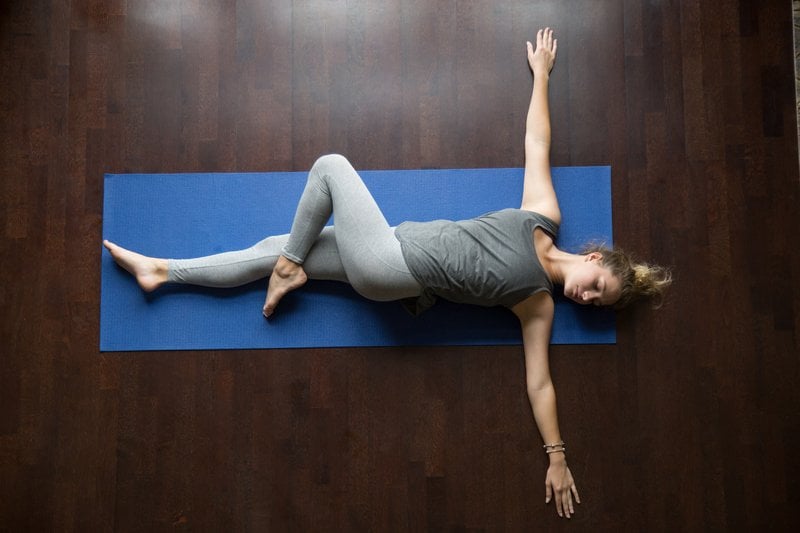Pillow Yoga Poses: 7 Positions You Can Do for Deep Relaxation

Just when you thought you’d seen and tried it all, there’s something new on the agenda: Pillow yoga poses for the bedroom to help you unwind and fully disengage from your day before falling into a truly restful and restorative sleep.
What is Restorative Yoga?
You’ve probably heard of yoga, and you may even engage in the practice on a regular basis, but have you ever heard of a specific type of yoga called “restorative yoga”? While yoga itself has been around for ages, restorative yoga was first brought to mainstream awareness in 2007 by Iyengar yoga teacher Judith Lasater. Her goal was to provide a more restful form of yoga than traditional classes typically offer.
How is restorative yoga different from a normal yoga class? Restorative pillow yoga requires a lot of concentration to fully relax and free your mind and body. The poses are often held for much longer than traditional yoga poses, which are generally held for seconds to a minute or two. Basically, restorative pillow yoga poses force you to slow down and unwind with passive stretches and very little movement.
This meditative form of yoga employs, at minimum, pillows and blankets but can also include other yoga props. Tools of the trade can include:
- Folded blankets
- Several pillows or bolsters
- Straps
- Blocks
- An eye cover
What are the Benefits of Restorative Yoga?
If yoga sounds like a soothing practice, restorative pillow yoga takes that to a new level with benefits like:
- Deep relaxation
- Stress relief
- Alleviating stiffness
- Releasing tension
- Decreasing depression
- Better digestion
- Relief for those close to burnout
- Soothing, restful sleep
- Deeper sleep
- Developing your mind-body connection
7 Restorative Pillow Yoga Poses to Try

1. Balasana Pose (Child’s Pose)
Begin with a pillow in front of you, placed lengthwise on the ground. Place one knee on each side of the pillow and sit back onto your hips. Fold your body forward at the waist and bring the torso down onto the pillow. Turn your head to the right while putting your arms around the pillow. Allow your torso to fully stretch out and the muscles in your back to fully relax as you use the pillow to support your core. Stay in this stretch for five to ten minutes, breathing deeply, but about hallway through, lift your head and turn it to the left, and place it on the pillow again. Then return to a seated position.
2. Side Supported Balasana (Twisted Child’s Pose)
This pose will begin in the same manner as Child’s Pose except that you will lie on your side next to the pillow. Place your right arm over the pillow and your right leg on the pillow and bend at the knee to form a 90-degree angle. Feel the tension release from your back as you gently twist your spine to the right. Hold this pose for five to ten minutes as you focus on your breath and repeat on the opposite side.
3. Paschimottanasana (Seated Forward Bend)
This pose has you sit with your legs out straight in front of you. Pile pillows and/or blankets on top of your legs until you can comfortably rest with your entire upper body draped over the pillows. (Use as many pillows or bolsters as you need, depending on your flexibility.) Put your arms where they are comfortable and enjoy the stretch through your back and glutes. Hold this pillow yoga pose for five to ten minutes while breathing slowly and deeply before returning to a seated position.
4. Viparita Karani (Legs-up-the-Wall Pose)
Start by putting a pillow against the wall and place your body on the pillow. You’ll want to bring your hips all the way up to the wall (resting on the pillow) and then gently walk your legs up the wall until they’re straight. Your back and buttocks should be fully on the pillow with your arms at your sides. Rest in this position for five or ten minutes as you allow your body to relax and unwind with your breath.
5. Supta Baddha Konasana (Reclining Butterfly/Goddess Pose)
This pose can assist in relaxation, lowering your blood pressure, while stretching your inner thighs, hips, and groin area. Lie on your back with a pillow under your head and neck as well as under each knee. Place your hands by your sides and the bottoms of your feet together, allowing your knees to fall to either side (away from each other). Feel the tension release from your hips and groin areas as well as your inner thighs and abdomen. Hold this pose for five to ten minutes as you breathe deeply.
6. Supta Virasana (Reclining Hero Pose)
This pose may be a bit advanced for some as it does require quite a bit of flexibility. Begin by placing a pillow (or more) behind you. Kneel in front of the pillow and position your knees on either side of the pillow. Next, gently lower yourself backwards until your hips and back are fully resting on the pillow. Your head can either rest on the pillow or gently hang off the back of the pillow. Cross your arms over your chest and let your chest, abs, and thighs stretch and release tension. Breathe deeply and hold this pose for five to ten minutes.
7. Savasana (Corpse Pose)
While it looks so easy, this pose is actually considered to be one of the most difficult yoga poses as it requires true and complete relaxation. Place a pillow under your head and rest comfortably on your back with your legs outstretched and your hands by your sides. (You can also skip the pillow if you find it more comfortable to do so.) Allow your legs to naturally fall slightly to the sides as you breathe in deeply, hold your breath, and slowly release it again. Feel all tension leave your body as you achieve full relaxation. Hold this pillow yoga pose for at least five to ten minutes or longer as you breath slowly and deeply to fully and completely relax and, since you’re already in bed, allow yourself to drift off to dreamland.
Pillow Yoga Poses: A Recap
Because it’s easier (and safer) to stretch a body that’s warm, many yoga teachers will begin a relaxing yoga practice with a few more difficult, warming movements. (Here are some great ones to start with.) Or you could also take an evening stroll before you begin your pillow pose practice. The main key with any of these pillow yoga movements is to get in tune with your breath and relax into the pose rather than “pushing” or trying to achieve a certain look or shape. Allow your body to be where it is, and enjoy this precious time to fully relax, let go, and be at ease.




 7 Signs Your Body is Seriously Low on Collagen (not just wrinkles)
7 Signs Your Body is Seriously Low on Collagen (not just wrinkles) Health Expert: "Turmeric Doesn't Work (unless...)"
Health Expert: "Turmeric Doesn't Work (unless...)" 3 Warning Signs Your Probiotic Supplement is a Total Waste
3 Warning Signs Your Probiotic Supplement is a Total Waste

